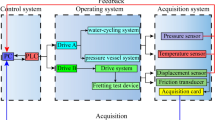Abstract
In support of a recent surge in research to develop an accident tolerant reactor, accident tolerant fuels and cladding candidates are being investigated. Relative motion between the fuel rods and fuel assembly spacer grids can lead to excessive fuel rod wear and, in some cases, to fuel rod failure. Based on industry data, grid-to-rod-fretting (GTRF) has been the number one cause of fuel failures within the U.S. pressurized water reactor (PWR) fleet, accounting for more than 70% of all PWR leaking fuel assemblies. APMT, an Fe-Cr-Al steel alloy, is being examined for the I2S-LWR project as a possible alternative to conventional fuel cladding in a nuclear reactor due to its favorable performance under LOCA conditions. Tests were performed to examine the reliability of the cladding candidate under simulated fretting conditions of a pressurized water reactor (PWR). The contact is simulated with a rectangular and a cylindrical specimen over a line contact area. A combination of SEM analysis and wear & work rate calculations are performed on the samples to determine their performance and wear under fretting. While APMT can perform favorably in loss of coolant accident scenarios, it also needs to perform well when compared to Zircaloy-4 with respect to fretting wear.
Similar content being viewed by others
References
Terrani, K. A., et al. (2014). “Advanced oxidation-resistant iron-based alloys for LWR fuel cladding.” Journal of Nuclear Materials 448(1–3): 420–435.
Edsinger, Nucl. News 53 (2010) 40.
Fisher, N. J., et al. (2002). “Fretting-wear of zirconium alloys.” Nuclear Engineering and Design 213(1): 79–90.
Blau, P. J. (2014). “A multi-stage wear model for grid-to-rod fretting of nuclear fuel rods.” Wear 313(1–2): 89–96.
Cho, K. H., et al. (1998). “Fretting wear characteristics of Zircaloy-4 tube.” Wear 219(1): 3–7.
Kim, H. K., et al. (2001). “Fretting wear of laterally supported tube.” Wear 250-251(PART 1): 535–543.
Guérout, F. M., Young, M. Y., Fisher, N. J., & King, S. J. (2005). Fretting-Wear Behavior of Zircaloy-4, OPTIN™, and ZIRLO™ Fuel Rods and Grid Supports Under Various Autoclave and Hydraulic Loop Endurance Test Conditions. Journal of ASTM International, 2(8), 1–24.
Author information
Authors and Affiliations
Rights and permissions
About this article
Cite this article
Winter, T., Huggins, J., Neu, R. et al. Fretting Wear Behavior of APMT Steel at 350°C for Reactor Fuel Cladding Application. MRS Advances 1, 2495–2500 (2016). https://doi.org/10.1557/adv.2016.532
Published:
Issue Date:
DOI: https://doi.org/10.1557/adv.2016.532




